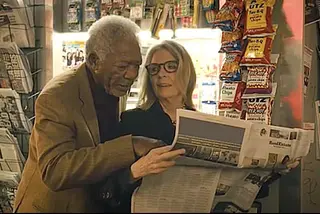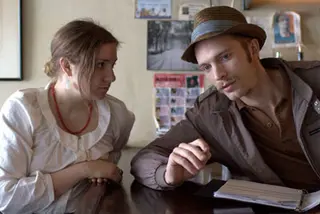Given the difficulty of finding, financing and keeping real estate in New York City, it is no surprise that the city’s real estate and housing woes have long figured prominently film. From the nightmare neighbor scenario depicted in "Rosemary’s Baby" to the proposed demolition of an Alphabet City walkup and arrival of aliens in "Batteries Not Included," cinematic depictions of the city’s real estate market are enough to make anyone wary of buying, selling or renting. Fortunately, several recent cinematic depictions of the city’s housing market are more realistic (there are no satanic cults or cute alien visitors in these films), but how realistic are they? Below we review and rank three of these films on the real estate and housing reality index.



Selling, Renting, Couch Surfing and Housing Miracles in Love is Strange
In this charming film, Ben (John Lithgow) and George (Alfred Molina), an older gay couple living in a Manhattan co-op, decide to get married after 40 years. Only a few days after their wedding, George, who teaches music at a Catholic school, loses his job. Realizing they will only have $3,000 per month in combined income, the couple is forced to sell. Because they still hold a large mortgage, however, their return on the sale is minimal, with most of the return being paid out to the broker and co-op or used to cover administration fees. Where does this leave Ben and George?The couple has two options. They can move to Poughkeepsie to live with Ben’s niece who naturally has ample space (but as emphasized in the film, “Of course she does—it’s Poughkeepsie!”), or they can stay with family and friends in New York City but live separately, since no one has room for two. They choose to stay in the city, but not without a cost. For Ben, the decision to stay means moving to his nephew’s loft in Brooklyn where he ends up sharing a room and a bunk bed with his nephew’s teenage son. George remains in Manhattan but is forced to crash on a former neighbor’s sofa. While Ben fights with his teenage roommate, George adjusts to his host’s all-night party schedule. Miserable and lonely, Ben and George look together for affordable housing options but soon learn that even subsidized units are nearly impossible to acquire with their myriad restrictions and lottery structure.
While "Love is Strange" generally ranks high on the reality index, the film’s ending loses considerable points. That’s when George meets a handsome young stranger at a party. When he starts to talk about his housing dilemma, the stranger takes him to a well-maintained rent-stabilized apartment that he has “inherited” from a relative. Better yet, the handsome young stranger is about to leave the country and gives the apartment to George. While every New York City renter has dreamt of this moment (meeting a stranger at a party gives who just happens to have a rent-stabilized apartment they are eager to handover), both the chance encounter and legality of the transaction lower the film’s reality ranking. On this basis, "Love is Strange" loses points.
RATING: 5.7 on our 10-point reality scale



Nightmare Brokers, Open Houses and Elevator Buildings in 5 Flights Up
In "5 Flights Up," former Sex in the City star Cynthia Nixon plays Lily, a high-strung real estate agent, who offers to help her aging Aunt Ruth (Diane Keaton) and Uncle Alex (Morgan Freeman) sell their Brooklyn flat, so they can purchase a unit in an elevator building. Nixon’s depiction of an NYC real estate agent likely will not gain her any friends in the profession, but there is no doubt that the character does convey the high-stakes and high-stress nature of the job. Likewise, the premise for Ruth and Alex’s move (the ubiquitous search for an elevator building as one ages) is highly realistic. Also realistic is the film’s depiction of the speed at which real estate deals typically unfold in New York City. In the city that never sleeps, time to carefully mull over buyer’s offers is also rare luxury.Most of "5 Flights Up" takes place during Alex and Ruth’s open houses. From Lily’s careful staging of their home, which includes instructions on what to hide, store or throw away, to the awkward parade of visitors who eventually arrive to make snide remarks and break fixtures, the film’s depiction of the open house also generally ranks high on the reality index. Yet, like "Love is Strange," "5 Flights Up" does not remain true to the end. As the film reaches its climax, bidders show up—without representatives—to deliver their bids in person. In a city where buying real estate is an especially complex legal and financial endeavor, buyers delivering bids in person without an agent is highly unrealistic.
RATING: 6.9 on our reality index



Adult Kids, Couch Surfing and Mom’s Tribeca Loft in Tiny Furniture
Before Lena Dunham became known for the hit television show "Girls," there was "Tiny Furniture"—her low budget but well-received 2010 film shot in her mother’s stunning Tribeca loft (when the loft later went on the market, it sold for $6.25 million). In this film, Dunham tackles a problem that plagues children and parents across the nation—adult children returning home after college. Of course, in New York City, this common practice raises unique challenges. After all, many parents (but evidently, not Dunham’s) have already reclaimed the “office/dining room” that was their child’s bedroom. Of course, even where there is room to spare, the return home of an adult child can be difficult, and this is the case in "Tiny Furniture."Like most adult children returning home, Aura promises her mother that she will move out “in a few months.” In the mean time, she spreads herself out around her mother’s loft and invites other couch-surfing twenty-something-year-olds to stay for days, drink her mother’s reserve of wine, and generally exhibit the type of behavior one hopes has passed by this point. So where does "Tiny Furniture" land on the reality index?
"Tiny Furniture" does an outstanding job depicting the tensions and dysfunction caused by the boomerang generation. Of course, in reality, most recent college graduates do not have the luxury of hanging out in a 3,600-square-foot loft when they return home to contemplate their next step in life. So, while the film’s plot may have accurately reflected the filmmaker’s reality, it still loses a few points on the reality index.
RATING: 8.4 on our reality scale

Contributing Writer
Cait Etherington
Cait Etherington has over twenty years of experience working as a journalist and communications consultant. Her articles and reviews have been published in newspapers and magazines across the United States and internationally. An experienced financial writer, Cait is committed to exposing the human side of stories about contemporary business, banking and workplace relations. She also enjoys writing about trends, lifestyles and real estate in New York City where she lives with her family in a cozy apartment on the twentieth floor of a Manhattan high rise.

 6sqft delivers the latest on real estate, architecture, and design, straight from New York City.
6sqft delivers the latest on real estate, architecture, and design, straight from New York City.
